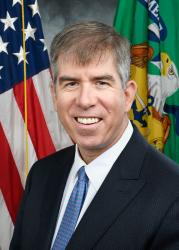The labor force participation of the veteran population is different than that of the nonveteran population in many ways. Far more veterans are in school during what are prime working years for the nonveteran population, which keeps some out of the labor force. Furthermore, as a consequence of the service, many veterans face physical disability and mental health challenges, though among those without self-reported disabilities, more veterans participate in the labor force than nonveterans.
Timely insights and details regarding the labor force participation of veterans are provided when the Bureau of Labor Statistics releases new monthly jobs data. This data release includes employment statistics regarding the almost 20 million men and women in the United States who are veterans—those who were previously on active duty serving in the U.S. Armed Forces and who have returned to civilian life.
Monthly, BLS presents key statistics—reported separately by the conflict in which veterans served—regarding how veterans are faring in the civilian labor market. These data, combined with analysis presented in this piece, show that younger veterans (age 25–34) participate in the labor force at rates lower than their nonveteran counterparts, but largely because more veterans are in school. Older veterans (age 35–54) participate at lower rates as well, but their lower participation stems largely from disability. Veterans without disabilities participate at rates slightly above those of nondisabled nonveterans.
As of September 2019, the labor force participation rate of nonveterans over the age of 18 was 74.4 percent for men and 58.7 percent for women. Among veterans, 48.2 percent of men and 58.4 percent of women participated in the labor force. Age has a great deal to do with the large gaps across these groups, and the lower participation rate for male veterans is mainly attributable to the fact that more older veterans are men. 83.3 percent of younger male veterans and 65.8 percent of younger female veterans—both from the Gulf War II era—participate in the labor force.
To better understand the labor market outcomes of veterans, we use detailed information from the 2013–17 American Community Survey to show how veterans differ from the nonveteran population on three dimensions relevant for labor force participation rates: postsecondary education take-up and timing, disability status, and place of residence.
So that age differences between veterans and nonveterans do not unduly affect our results, we focus on participation rates for prime-age (age 25–54) individuals. In addition, because today all veterans must have at least a high school equivalent-degree to join the military, we compare them to nonveterans with a high school degree or more. For these groups, overall labor force participation rates among veterans are lower than among adults who did not serve. Labor force participation rates are 86 percent for male veterans versus 89 percent for male nonveterans, and 77 percent for female veterans compared to 79 percent for female nonveterans.
However, focusing only on labor force participation rates understates the extent to which veterans are making productive use of their time. While labor force participation rates measure the degree to which people are working or seeking work, they do not distinguish between the various activities of nonparticipants, including schooling. Because veterans were enlisted during the ages typically associated with postsecondary schooling, they may be engaged in education at ages when nonveterans have generally finished schooling. In fact, more than 700,000 veterans took advantage of the post-9/11 GI Bill in 2018.
Work and school can be combined in one of four ways. A veteran can be (1) a labor force participant and not enrolled in school, (2) a labor force participant and enrolled in school, (3) not a labor force participant and enrolled in school, or (4) disengaged, meaning that they are neither a labor force participant nor enrolled in school. Figures 1 and 2 show how the mix of these labor force participation and education statuses differed by those who were veterans versus nonveterans, broken down by age and gender.
Veterans are substantially more likely to be students during their prime working years and to combine labor force participation with continuing education. While this pattern is evident when comparing male and female veterans to nonveterans, prime-age female veterans are most likely to enroll in postsecondary education. For example, among those between the ages of 25 and 29, 40 percent of female veterans were enrolled in school (two-thirds of whom were also in the labor force); 29 percent of male veterans in this age group were enrolled in school. Delays in schooling may be caused by military service, but postsecondary education benefits are material and in most cases more generous for veterans than education benefits provided to civilians, likely adding to the increased schooling rates for veterans.

These data demonstrate that while prime-age veterans are relatively less likely to be in the labor force than their nonveteran counterparts, it is not because they are idle. When combining levels of labor force participation and school enrollment, veteran engagement is higher for males aged 25–40 and for females aged 25–50.

Veterans and Disability
Beyond the gaps in labor force participation associated with different enrollment rates, disability status influences labor force participation as well. Roughly 30 percent of prime-age Americans who are not in the labor force report a disability. About a quarter of veterans have a service-connected disability and more than five million veterans received service-connected (meaning incurred or aggravated during service) disability compensation in 2018, suggesting that disability is likely one reason veterans have lower labor force participation than nonveterans.
Figure 3 shows prime-age labor force participation rates for male and female veterans and nonveterans by type of self-reported disability. (These data do not distinguish between service-related disability and disabilities that could have occurred as a veteran.) The labor force participation rates for those without a disability are indistinguishable between male veterans and male nonveterans (both roughly 92 percent) and are 2.3 percentage point higher for female veterans than female nonveterans. Among individuals who report a disability, veterans have higher participation rates (55 percent for males and 47 for females) than nonveterans (51 percent for males and 46 for females). Even though disabled veterans participate in the labor force at higher levels than disabled nonveterans, it is the large share of veterans who are disabled that keeps the overall veteran labor force participation rate below that of the nonveterans. Further, as the figure shows, veterans’ participation varies by type of disability, but the substantial labor force participation of those with disabilities (veteran or not) demonstrates that many disabilities need not impede labor force engagement.

Veteran Participation and Location
Veterans are not located uniformly across the country. Given the wide range of participation rates across locations, it is possible that veterans’ place of residence could influence their labor force participation. Figure 1 shows the share of the prime-age (age 25–54) population who are veterans from the places with the fewest veterans (where fewer than 3 percent of the prime-age population are veterans) to the places with the most veterans (where more than 12 percent of the prime-age population are veterans). The map is divided by PUMA, which are geographic units that contiguously divide the US into divisions with no fewer than 100,000 people. This figure shows that veterans disproportionately reside in the mid-Atlantic, Southeast, and the West. This residency reflects in part pre-recruitment patterns—for example, in 2017, 44 percent of those enlisted were from the South and 46 percent of veterans lived in the South in 2017—but also patterns of residency during active duty.

As shown in the embedded table, location does not seem to drive male veteran participation rates. Areas with high veteran populations have roughly the same nonveteran participation rates as areas without many veterans. Furthermore, the places with the most veterans are places where male veterans are most likely to participate in the labor force. This pattern is different for women. Places with large numbers of veterans are, by contrast, the places where female veterans have the lowest participation rates (unlike female nonveterans). On net, though, it does not appear that the concentration of veterans in particular places makes them more or less likely to participate in the labor force. Rather, school enrollment and disability status seem to be far more important factors in determining veterans’ labor force participation.
The recent Hamilton Project framing paper “Labor Force Nonparticipation: Trends, Causes, and Policy Solutions” offers broad solutions to some of the issues that are relevant to both veterans and nonveterans—particularly human capital, health and disability, and geographic gaps in participation. As this analysis shows, understanding why particular groups are in or out of the labor force is an important part of understanding what policy levers may help bring more individuals into the labor force.
The Brookings Institution is committed to quality, independence, and impact.
We are supported by a diverse array of funders. In line with our values and policies, each Brookings publication represents the sole views of its author(s).










Commentary
Veterans are engaged in the labor force and in the classroom
October 31, 2019